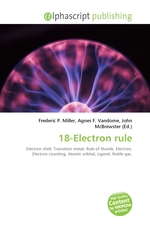18-Electron rule
Frederic P. Miller, Agnes F. Vandome, John McBrewster
бумажная книга
The 18-electron rule is a rule of thumb used primarily in transition metal chemistry for characterizing and predicting the stability of metal complexes. Valence shells of a transition metal can accommodate 18 electrons: 2 in each of the five d orbitals (10 in total); 2 in each of the three p orbitals (6 in total); and 2 in the s orbital (see Electron counting). In practice, of course, these orbitals cannot directly accept electrons, otherwise one would encounter ions such as Fe10? and Pt8?. However, combination of these atomic orbitals with ligand orbitals gives rise to nine molecular orbitals which are either metal-ligand bonding or non-bonding. (There are also some higher energy anti-bonding orbitals). The complete filling of these nine lowest energy orbitals with electrons, whether those electrons originate from the metal or from any ligands, is the basis of the 18-electron rule. When the metal has 18 electrons, it has then achieved the same electron configuration as the noble gas at the end of the period.
Данное издание не является оригинальным. Книга печатается по технологии принт-он-деманд после получения заказа.


